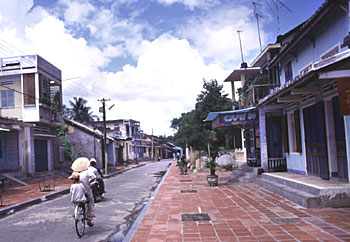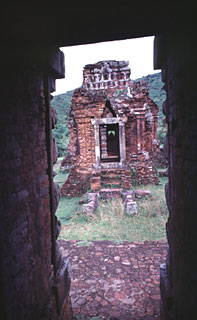Historic Hoi An
Backpackers have discovered Vietnam's secret hideaway. Only the coastal port of Hoi An has been a favorite haunt of seafarers for at least five centuries. And many left their mark on this historic port.
By Ron Gluckman /Hoi An
WHAT'S THE COOLEST HANGOUT along the backpacker belt in Asia?
Nope, not Thailand's Maya Bay (made famous by Leo DiCaprio and the rest of the cast of The Beach), but central Vietnam's Hoi An.
 Located
30 km down the coast from Danang (with airport access to Hanoi, Ho Chi Minh and
many regional cities), Hoi An sits astride a river, close to spectacular beaches
and some of the finest ruins in Asia.
Located
30 km down the coast from Danang (with airport access to Hanoi, Ho Chi Minh and
many regional cities), Hoi An sits astride a river, close to spectacular beaches
and some of the finest ruins in Asia.
But the town itself is the true attraction. Inside this quiet settlement are dozens of Internet cafés, bookshops, guesthouses and budget eateries catering to Hoi An's newfound popularity among the Lonely Planet set.
Not that this hideaway is an entirely new discovery. For centuries, Hoi An was a heralded trading port in a circuit that included Macau and Melaka. Known in days past as Faifo, Hoi An attracted seafarers from Japan, China and the Philippines.
They left behind temples and bridges, and the Europeans later added charming colonial mansions. More than 800 historic structures have been catalogued, and many old buildings have been converted into art galleries.
Yet the town's timeless flavor is largely unaltered. You can still watch fishermen tossing nets on the river and craftsmen carving wood in traditional ways.
 Just
a short day-trip away are the evocative Champa ruins at My Son. Practically
enveloped by jungles, this UNESCO site is grouped among other fabulous
Indian-influenced cities: Angkor in Cambodia, Bagan in Burma, Borobudur in
Java.
Just
a short day-trip away are the evocative Champa ruins at My Son. Practically
enveloped by jungles, this UNESCO site is grouped among other fabulous
Indian-influenced cities: Angkor in Cambodia, Bagan in Burma, Borobudur in
Java.
Although the ruins are the largest surviving remnants of Vietnam's Champa kingdom, dating to the 4th century, My Son is smaller than its better-known contemporaries. Hidden away and seldom visited, My Son's major charm, like that of nearby Hoi An, remains its understated grandeur and the secret offerings just waiting to be rediscovered.
Ron Gluckman is an American reporter who is based in Hong Kong, but who roams around Asia for a number of publications, such as Time, which ran this package of stories in its TravelWatch section in December 2000.
See also Hanoi hotels and Hoi An, the secret hideaway.
To return to the opening page and index
push here
[right.htm]
